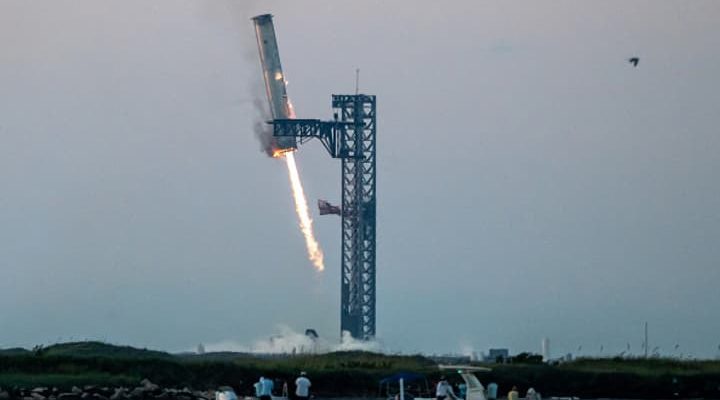SpaceX, the private aerospace company led by Elon Musk, reached a significant milestone by successfully catching the Super Heavy booster on its first attempt. The achievement, celebrated worldwide, is the result of years of rigorous planning and engineering work. The process of catching the world’s largest rocket booster involved thousands of distinct vehicle and pad criteria, meticulously addressed by SpaceX’s engineering team. Spain, with a growing interest in space technology, has closely followed these developments, as the implications extend beyond national borders, representing a major step toward reusable rocketry and more affordable space exploration.
A Breakthrough in Reusable Rocket Technology
Reusable technology has become a cornerstone of SpaceX’s mission to reduce the cost of accessing space. The Super Heavy booster, which forms the first stage of SpaceX’s next-generation Starship system, plays a critical role in transporting large payloads and humans to destinations like the Moon and Mars. The innovative approach of catching the Super Heavy mid-air, rather than allowing it to land on legs or splash down in the ocean, is meant to increase operational efficiency and speed up launch turnaround times. This method marks a departure from SpaceX’s Falcon 9 booster recovery, which lands on drone ships or landing pads. The new technique reduces wear and tear on the booster while eliminating the need for costly refurbishments.
SpaceX engineers had to develop thousands of specific criteria to ensure the success of this complex operation. Both the vehicle design and the launch tower, often called the “Mechazilla” arm, had to be calibrated with extreme precision. The catch mechanism required detailed planning to synchronize the booster’s descent with the robotic tower arms, taking into account aerodynamic forces, thrust control, and environmental variables such as wind and temperature.
Spain’s Space Community Reaction
Spain’s space community has shown a strong interest in SpaceX’s innovations. The Spanish government, through its national space strategy, aims to foster the development of satellite technology and expand participation in international space missions. The success of SpaceX has inspired growing collaboration between private companies and research institutions in Spain. For example, Spain’s aerospace sector is working on micro-satellites and propulsion technologies, some of which could benefit from lower-cost access to orbit through systems like Starship. Additionally, the country has been involved in projects under the European Space Agency (ESA) that align with the broader goals of SpaceX’s reusable rocketry.
SpaceX’s success story also resonates with aspiring engineers and students in Spain, where universities are increasingly offering programs focused on aerospace technology and space exploration. The company’s ability to catch the booster on the first attempt demonstrates the importance of perseverance, ingenuity, and precision—qualities that are being emphasized in Spain’s evolving engineering curricula.
A New Era in Space Exploration
The successful catch of the Super Heavy booster marks the beginning of a new era in space exploration. This achievement aligns with SpaceX’s long-term vision of establishing human settlements on other planets. For Spain, the advancements made by companies like SpaceX open doors for more collaboration in the global space industry, including participation in lunar missions and the future exploration of Mars. As reusable rockets become more efficient and affordable, Spain’s role in space exploration, whether through the ESA or private partnerships, is likely to grow.
SpaceX’s accomplishment is more than just a technical feat; it is a testament to the relentless dedication of engineers who overcame countless challenges. This triumph, achieved on the first attempt, sends a clear message that humanity is on the brink of making space more accessible than ever before. Spain, with its growing interest in space and engineering talent, stands ready to take part in this exciting new chapter of exploration.



